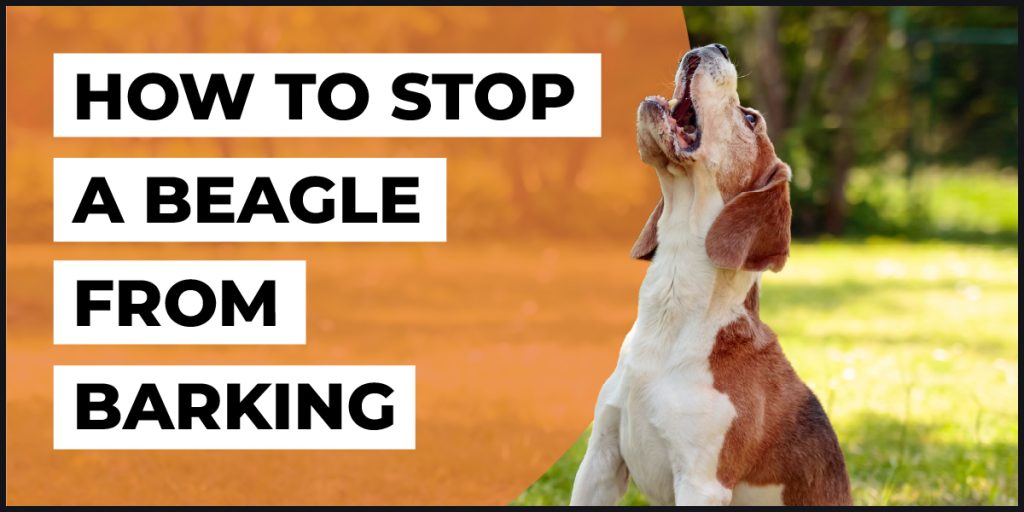Have you ever been on the phone trying to have an important phone conversation, meanwhile your beagle insists on having a max volume, vocal performance at the worst possible moment? Or perhaps you're hosting guests for a get-together and your beagle is committed to barking incessantly at every new person entering your home?
 If you've ever found yourself in these situations, or similar situations that have you battling relentless barking from your beagle, you know it's a challenge that can really test your patience. But don't worry, you're far from being alone in this.
If you've ever found yourself in these situations, or similar situations that have you battling relentless barking from your beagle, you know it's a challenge that can really test your patience. But don't worry, you're far from being alone in this.
The beagle dog breed, as adorable as they are, is known for their vocal nature. But here's the good news: with the right knowledge and techniques, you can learn how to teach your beloved dog how to stop barking.
In this guide, we focus on helping you understand your beagle’s barking behavior, effective dog training techniques, how to address separation anxiety, ensuring proper exercise, and much more. So, buckle up, and let’s embark on this journey to a more peaceful home environment for you, your beagle, and the friends and family in your life.
Keys To A Successful Start:
- Understand your Beagle’s barking behavior and identify triggers.
- Use positive reinforcement, desensitization, and redirection to stop barking excessively.
- Socialize your dog with other dogs & animals for improved social skills & reduced reactive barking when other dogs bark.
- Know your dog will only be successful if you are consistent and committed to the training yourself (along with any other ‘humans' consistently present in the dog's life).
Find out how to train your beagle to be the well-behaved pup you desire – Read Free Report
Understanding Your Beagle's Barking Behavior

Understanding the reasons behind your Beagle’s barking is key to addressing it. Beagles, like most dogs, use barking as a form of communication. In addition, beagles strong hunting instincts and keen sense of smell often trigger their vocalizations, which serve them well in the hunting environment, but not so much in the home environment (more on that in a minute). In addition, emotional triggers such as stress, excitement, and fear can also lead to excessive barking.
Hunting Instincts and Communication
Beagles, a popular dog breed also known as barking beagles, were originally bred as hunting dogs, specifically for tracking rabbits and hares. Their exceptional sense of smell and tracking instincts set the foundation for them to become skilled hunters. Barking is integral to their hunting success, as it allows them to communicate with their owners or dog-hunting companions and inform them of the location of prey. This strong instinct to vocalize during hunting has become an ingrained part of their personality and barking behavior.
When interacting with other dogs, Beagles use barking as a form of communication to express excitement, curiosity or initiate play. Barking can also be used as a territorial warning or to establish dominance. A clear comprehension of the role of hunting instincts and communication in your Beagle’s barking will allow you to address the behavior of your dog more effectively.

Emotional Triggers
Emotional triggers such as stress, excitement, and fear can also contribute to lots of barking in Beagles. They may bark constantly or howl to express their excitement and seek attention, while fear can manifest in dog behaviors like:
- shaking
- pacing
- whining
- tail tucking
- hiding
- barking
- aggression
Identifying and addressing these emotional triggers is one of the most important first steps you want to tackle as the dog owner and trainer. Having clarity around what your dog's specific emotional triggers are (and each beagle is different) will help facilitate the management of your Beagle’s barking behavior and safeguard their emotional well-being.
Common Dog Barking Scenarios
In addition to their hunting instincts and emotional triggers, beagles bark excessively in various scenarios, including:
- Attention-seeking
- Territorial
- Frustration
- Boredom
- Alarm
The more aware beagle owners become of the scenarios that cause their dog(s) to bark, the easier it will be to help your dog to control those urges. In addition, knowing clearly the unique needs of your dog will allow you to seek out the appropriate tips for beagle owners on dog training techniques and strategies to reduce your Beagle’s barking. Let's get to it!
15 Techniques to Stop Excessive Dog Barking

As mentioned, understanding the reasons behind your dog's barking is critical. It's a great idea to journal or write down the details of your reflections about what causes your dogs to bark and any pertinent details related. This will come in handy as you continue to work with your dog over time to reduce or stop the barking.
The most common reason beagles do not succeed with bark training is due to the human's lack of consistency which creates confusion and frustration for all parties involved. So, keep notes, write things down, and stay consistent. Oh, and most importantly, remember that change does not happen overnight. Expect to experience “failing forward” on your path to success. Failure is part of the success equation… keep going, don't stop. With that, let’s explore techniques to curb this barking behavior. Some of the most effective techniques to stop excessive dog barking include positive reinforcement, desensitization, and redirection.
Consistent and patient implementation of these methods can train your Beagle to remain calm and quiet in various situations.
#1 – Positive Reinforcement

Positive reinforcement is a training technique that involves rewarding desired behavior to encourage its repetition. In the context of controlling your Beagle’s barking behavior, positive reinforcement can be used by providing rewards, such as dog treats or praise, when your Beagle remains calm and quiet in situations where they would typically bark. This helps your dog understand that being quiet is the desired behavior.
Some common mistakes to avoid when using positive reinforcement when barking begins include unintentionally reinforcing the barking behavior by giving attention or treats when the dog barks and not following up with positive reinforcement (giving a treat) when the dog stops barking. Mindfulness of these pitfalls enables effective use of positive reinforcement to reduce your Beagle’s excessive barking.
#2 – Desensitization
Desensitization is a process that involves gradually exposing your Beagle to their triggers at a comfortable distance, rewarding calm behavior, and then gradually decreasing the distance between the dog and the trigger. Slowly desensitizing your dog to the stimuli that cause them to start barking helps them become less reactive, thus reducing how much your beagle barks.
#3 – Redirection
Redirection is a technique that involves guiding your Beagle’s attention away from the trigger that is causing them to bark. Providing a distraction to your dog, like a toy or activity, prevents reactive beagle barking and encourages more appropriate behavior. Redirection can be a helpful tool in managing your beagle barks, especially when used in conjunction with positive reinforcement and desensitization.
Addressing Separation Anxiety in Beagles

Separation anxiety can be another cause of excessive barking in Beagles. Addressing separation anxiety involves identifying signs of anxiety, creating a safe and comfortable environment for your Beagle, and building their confidence and independence.
Addressing separation anxiety reduces anxiety-related barking and ensures a happier, calmer Beagle.
#4 – Identifying Signs of Separation Anxiety
Signs of separation anxiety in Beagles can include:
- barking, howling, and whining
- destructive behavior like chewing, digging, and scratching
- peeing or pooping inside
- pacing
Recognizing these signs can help you determine if your Beagle dog is experiencing separation anxiety and take the necessary steps to address it.
#5 – Creating a Safe and Comfortable Environment
Creating a safe and comfortable environment for your lonely beagles can help reduce anxiety-related barking. This can include providing them with:
- a cozy bed
- a place for comforting toys and enrichment items
- include access to water
- create a barrier to other distractions or noise
- using calming scents and soothing sounds
Creating a secure and comfortable environment when you are away from home can alleviate most beagle's separation anxiety.

#6 – Building Confidence and Independence
Building confidence and independence in your Beagle can help alleviate separation anxiety. Here are some strategies to try with your dog:
- Gradually increase the amount of time your Beagle spends alone
- Provide them with interactive toys and puzzles to engage their minds
- Ensure they receive adequate exercise and that you can engage their mind
By implementing these strategies, you can help your Beagle feel more confident and independent when left alone.
Promoting independence and confidence in your Beagle helps them feel more secure when left alone, reducing their anxiety-related barking.
Ensuring Proper Exercise and Mental Stimulation

Proper exercise and mental stimulation are pivotal in reducing excessive barking in Beagles. Exercising and providing things to work out mentally for a Beagle can help reduce barking caused by boredom. This can result in a happier, healthier dog.
In this section, we will explore daily exercise requirements, interactive toys and puzzles, and techniques for your Beagle.
#7 – Daily Exercise Requirements
Most Beagles require daily exercise to maintain their physical and mental health. It is recommended that a Beagle have 1.5 to 2 hours of exercise and physical stimulation per day, which can be divided into multiple sessions. A consistent exercise routine for your dog can control excessive barking, prevent them from getting bored and ensure their overall well-being.
Weather conditions can impact your Beagle’s exercise routine, so it is important to take this into consideration and make appropriate adjustments. In extreme temperatures, be mindful of potential health risks and avoid exercising your Beagle.
During extreme weather conditions outside (hot or cold), consider indoor exercise options to ensure your Beagle gets the physical activity they need.
#8 – Interactive Dog Toys and Puzzles
Beagles love being entertained. Interactive toys and puzzles can help keep bored Beagles mentally stimulated and reduce boredom-related barking. These toys require the Beagle to think and figure out how to access treats or rewards, which can help keep their minds occupied and prevent boredom.
A variety of interactive toys and puzzles for your Beagle encourages mental stimulation, contributing to a well-behaved, content Beagle.
#9 – Mental Stimulation Techniques
Techniques, such as doggy brain training techniques, scent games, and food puzzles, can provide both physical and mental exercise for your Beagle. These activities can help keep your Beagle’s mind sharp, reduce boredom, and prevent excessive barking.
Incorporating mental stimulation techniques into your Beagle’s daily routine helps ensure a well-rounded and well-behaved companion.
Training Commands to Control When Your Beagle Barks

Training commands can be an effective way to control your Beagle’s barking behavior. Teaching your Beagle the “quiet” and “speak” commands” with a few training sessions can help them understand when barking is appropriate and when it is not.
Successful training hinges on consistency and patience. Thus, maintain a consistent approach and remain patient with your Beagle as they learn.
#10 – Teaching the “Quiet” Command
The “quiet” command can be an effective way to control your Beagle’s excessive barking. Here’s how to train your Beagle to respond to the command:
- Start by familiarizing your Beagle with the command while they are barking.
- Say “quiet” in a calm and audible voice.
- Reward your dog with tasty treats and praise when they stop barking.
Consistent reinforcement of the “quiet” command teaches your Beagle to stop barking on command.
#11 – Teaching the “Speak” Command
Teaching your Beagle the “speak” command can help them understand when barking is appropriate. To teach the “speak” command, follow these steps:
- Prompt your Beagle to bark.
- Express appreciation and say “Bark” in a cheerful, enthusiastic voice.
- Reward them for their hard work. A small treat will show them you appreciate their efforts.
Having your Beagle bark on command aids in managing their beagle barking behavior and improves communication with your furry friend, especially when your beagle barks at appropriate times, unlike random dog’s barking.
#12 – Consistency and Patience in Dog Training
Consistency and patience are essential for achieving successful training results. Remaining consistent in the commands and rewards given, and demonstrating patience as your Beagle learns is vital. Inconsistent training can lead to mixed signals and behavioral issues, so be sure to establish a routine and provide clear expectations for your Beagle.

OMG Beagle's Free Report: Your Guide to a Well-Behaved Beagle
To further assist you in training your Beagle to stop barking, OMG Beagle offers a free report that provides comprehensive training techniques and benefits for a well-behaved Beagle. This valuable resource covers topics such as:
- Obedience training
- Housebreaking
- Leash training
- Socialization
- Basic commands
Download and utilize this free report to get additional support in your journey to train your Beagle and enjoy a more peaceful home environment.
#13 – Dog Training Guidance
The free report includes guidance on how to control barking. Having a guide to follow that includes advice from professional dog trainers allows dog owners to feel more confident about the implementation of training methods that reduce your Beagle’s excessive barking and improve their overall behavior.
With consistent application of these techniques, you can enjoy a happier, well-behaved Beagle.
Benefits of a Well-Behaved Beagle
A well-behaved Beagle not only makes for a more peaceful home environment but also contributes to the happiness of your furry friend. Training your Beagle to control their barking can help prevent boredom and reduce pent-up energy and frustration.
This can lead to a happier, more content adult Beagle and a more enjoyable living situation for you, your family members, and your beagle puppy, especially when there are many dogs in the household.
Downloading and Utilizing the Free Report
Don’t let this valuable resource to train your Beagle to stop barking slip by. Download OMG Beagle’s free report and get the information you need about effective dog training techniques today.
With dedication, consistency, and patience, you can enjoy the benefits of a well-behaved Beagle and a more peaceful home environment.
Within the report, you will also access OMG Beagle's recommendation to take your dog training to the next level.
The Role of Bark Collars and Other Tools
While training techniques are crucial in controlling your Beagle’s barking, bark collars and other tools can also play a role in managing this behavior this stubborn breed. It’s important to understand the options, pros and cons, and alternative tools available to help you make the best decision for your Beagle.
#14 – Bark Collar Options
There are several bark collar options available for the Beagle breed, including citronella, ultrasonic, and static shock collars. Each type of collar works differently, and it’s crucial to choose the right collar for your Beagle’s needs.
Before using a bark collar, consider the potential impacts on your Beagle’s health and behavior, and pair the use of these tools with proper training techniques.
Pros and Cons of Bark Collars
Bark collars can be effective in controlling nuisance barking, but they come with their own set of pros and cons. Some advantages include their effectiveness in controlling barking and providing quick results. However, potential disadvantages include the possibility of physical discomfort, psychological distress, aggressive behavior, and negative associations.
Before using a bark collar, weigh the pros and cons and investigate alternative tools and training methods.
Alternative Tools for Barking Control
If you’re considering alternative tools for barking control, ultrasonic devices and calming aids might be useful options for this breed. Ultrasonic devices emit high-pitched sound frequencies that are unpleasant for dogs and can help disrupt their barking pattern. Calming aids, such as synthetic pheromones or Thundershirts, can help create a sense of calm and reduce anxiety in your Beagle.
Exploring various dog tools and techniques helps you find the best approach to control your Beagle’s barking behavior.
Socializing Your Beagle with Other Dogs and Animals

Another aspect of reducing excessive barking is socializing your Beagle with other dogs and animals. Proper socialization can help your Beagle become more comfortable around other animals, improve their social skills, and reduce reactive barking.
In this section, we will discuss the benefits of early socialization and how to introduce your Beagle to other dogs and animals.
Benefits of Early Socialization
Early socialization can have a significant impact on your Beagle’s behavior and their ability to interact positively with other animals. By exposing your puppy to various people, animals, and environments during their early development stages, they are less likely to display fear or aggression-based barking.
Socialization also helps most Beagles become more confident and comfortable in different situations, reducing the likelihood of excessive barking.
#15 – Introducing Your Beagle to Other Dogs and Animals
Introducing your Beagle to other dogs and animals should be done in a controlled environment to ensure a positive experience for all involved, regardless of any negative perceptions like why beagles are the worst dogs. Start by allowing the dogs to greet each other and sniff while observing their body language and keeping the leashes loose. Proceed slowly and observe their interactions carefully.
Introducing your Beagle to other animals in a calm and controlled manner helps improve their social skills and reduce excessive barking.
Summary
In conclusion, understanding and addressing your Beagle’s barking behavior is essential for both your peace of mind and your Beagle’s well-being. By implementing effective training techniques, ensuring proper exercise and mental stimulation, addressing separation anxiety, and socializing your Beagle with other animals, you can effectively reduce excessive barking and enjoy a more peaceful home environment. With dedication, consistency, and patience, you can transform your Beagle into a well-behaved and happy beagle companion.
Frequently Asked Questions
Can you train a beagle not to bark?
With some training and the use of positive reinforcement, a Beagle can be taught to limit their barking and live peacefully within their environment.
Why does my Beagle bark so much?
Beagles bark for a number of reasons such as wanting something, getting attention, or suffering from separation anxiety. Understanding why your Beagle barks will help you find the best solution to ensure it is happy and healthy. Read about other beagle pros and cons here.

Do bark collars work on beagles?
Overall, bark collars are an effective form of bark control with a high success rate. Finding the most appropriate approach to a collar (ie, citronella, ultrasonic, and static shock collars) for your dog specifically, is critical.
How do I get my Beagle to stop barking at strangers?
Identify your Beagle's triggers and teach it the “Quiet” command. Use counter-conditioning, positive reinforcement, and redirect its attention to help it stop barking at strangers.
What triggers excessive barking in Beagles?
Beagles may bark excessively due to their hunting instincts, emotional triggers like stress and fear, or various barking scenarios such as attention-seeking, territorial, frustration, being bored, and alarm barking.
Learn how to train your beagle to be the well-behaved dog you desire –> Access our Free Report
Shop for beagle-themed products and gifts that beagle enthusiasts will love.
